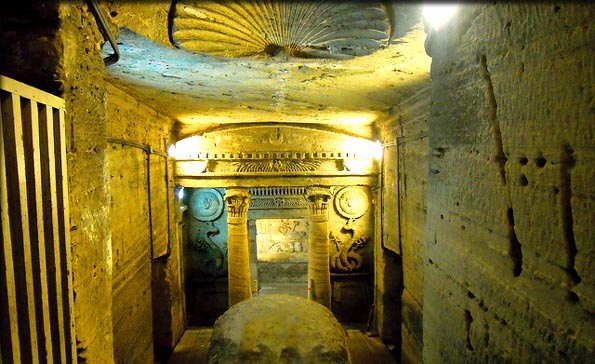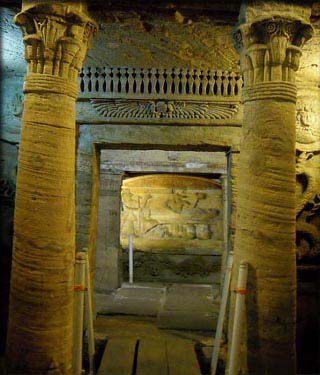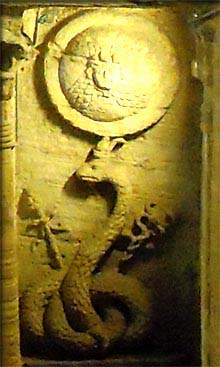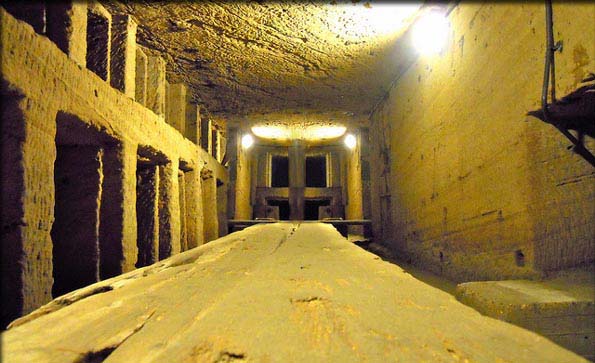 |
The
Catacombs of Kom el Shoqafa
|

Tradition has it that on Friday, September 28th,
1900, in Alexandria, Egypt, a donkey, hauling a cart full of
stone, made a misstep and disappeared into a hole in the ground.
If that story is accurate, this beast of burden made one of
the most astounding discoveries in archeological history: A
set of rock-cut tombs with features unlike that of any other
catacomb in the ancient world.
We actually don't know if the donkey story is
true or not, but records do show that the shaft was reported
to authorities by a man named Monsieur Es-Sayed Aly Gibarah.
Following the rules about such finds in those days, he sent
a message to the local museum saying, "While quarrying for stone,
I broke open the vault of a subterranean tomb. Come see it,
take the antiquities if there are any, and authorize me to get
on with my work without delay." The curator, tired of being
called out to sites and finding nothing of importance, didn't
go himself, but sensing the man's impatience to get on with
the work, sent two of his assistants home early, telling them
to check out the find on the way. What they found brought the
curator out the next day and he spent much of the rest of his
life documenting this unique discovery.
|
Seven
Quick Facts
|
| Maximum
depth below ground: 100 feet (30m) |
| Rediscovered:
September 28th, 1900 |
| Made
by: Cutting into the natural underground rock. |
| Constructed:
2nd Century AD |
| Function:
Tombs with ceremonial feasting hall. |
| Style:
Mixture with Egyptian, Greek and Roman elements. |
| Other:
Supposedly discovered when a donkey fell through a hole
in the ground. |
Paris
of Antiquity
Archeologists believe that the Catacomb of Kom
el Shoqafa was started in the 2nd century A.D. and was used
to intern the dead for the next 200 years. This was a period
in the history of the city of Alexandria when there was a great
mixing of different cultures. Of course, there was the ancient
history of the great Egyptian kingdoms which went back thousands
of years. Also in 332 B.C. Alexander the Great had conquered
the land, established the city of Alexandria, and started a
dynasty of Greek rulers who brought their own culture to the
metropolis. Finally, in 31 B.C. the Romans took control of the
city and added their traditions.
This made Alexandria, which was then the capital
of Egypt, into what some have called "The Paris of antiquity."
People combined the elements of these three great cultures together
in surprising ways. Though much of this has now disappeared
from modern Alexandria, deep in the Kom el Shoqafa catacombs,
the intellectual blend of those times is still apparent.
These catacombs are not the only ones that were
constructed in ancient Alexandria. Such structures were part
of a Necropolis (or "city of the dead") that was probably built
(according to Egyptian tradition) on the western edge of the
town. Most of the rest of the Necropolis, however, was probably
destroyed over the centuries by earthquakes or new construction.
Archeologists speculate that Kom el Shoqafa was started as a
tomb for a single, wealthy family, but was expanded into a larger
burial site for unknown reasons. Most likely the facility was
eventually run by a corporation which was supported by members
who paid regular dues.
|

The
doorway into the "temple."
|
The name of the site, Kom el Shoqafa, means
"Mound of Shards." The name comes from heaps of broken pottery
in the area. Archeologists believe that these were left in ancient
times by relatives who would visit the tomb bringing food and
drink with them. The visitors, not wanting to bring vessels
that had been used at a gravesite back to their homes, would
shatter them and leave them behind in piles.
Layout
of Tomb
On the surface above the catacombs in ancient
times was probably a large funerary chapel. From the remains
of this edifice an 18-foot (6m) wide, round shaft descends into
the underground structure. Running around the outside of the
shaft but separated by a wall is a spiral staircase with windows
into the shaft that allow light coming from the surface to illuminate
the stairs. It is likely that the shaft also enabled the bodies
of the deceased to be lowered down to the deeper levels through
a rope and pulley system rather than being carried down the
steps.
At the junction of the uppermost underground level
and the stairs there are seats caved into the stone where visitors
could rest. A short passage from here leads to the rotunda room,
which overlooks a round shaft that continues down to the lower
levels. To the left of the rotunda room is a funeral banquet
hall known as the "Triclinium." It is here that relatives would
participate in annual, ceremonial feasts to honor the dead.
Steps from this upper level continue down to the
middle level which is the main part of the tomb. This section
is laid out much like a Greek temple. At the bottom of the steps
is the pronaos, or porch, of the temple set between two
columns. This area was originally designed to be surrounded
by a single u-shaped corridor that contained the burial niches.
As more space was needed, however, additional rooms and halls
were added, turning the complex into a labyrinth.
Below the middle level, at the lowest level, additional
internment niches are located, but that area is flooded and
inaccessible to visitors.
Blend
of Styles
|

The
Agathodaimon wearing an Egyptian double crown and carrying
a Roman kerkeion (right) and a Greek thyrus (left).
|
The main tomb at the middle level is covered with
the sculpture and art that makes this catacomb unique. For example,
in the room behind the temple pronaos are statues of a man and
woman (perhaps representing the original occupants of the tomb).
Both of the statues' bodies have been carved into the stiff
hieratic poses found in ancient Egyptian art. The man's head,
however, has been chiseled into the lifelike style favored by
the Greeks. In the same way the woman's head has been carved
with a Roman hairstyle.
On either side of the doorway of the temple's
facade there are two serpents carved in relief. These are meant
to guard the tomb. They represent a Greek Agathodaimon
(which is a good spirit). The Greek serpents are wearing traditional
Egyptian double crowns, however, and in their coils they carry
both a kerkeion (a winged staff) which is a Roman insignia and
a Greek thyrus (a staff topped by a pinecone). Above the serpents'
head are Greek shields carrying the image of the legendary Greek
monster Medusa (whose use here is meant to ward off unfriendly
intruders).
It is this mix of art and culture - Egyptain,
Greek and Roman - that is not found in any other catacomb in
the ancient world that makes Kom el Shoqafa special.
From the rotunda it is possible to enter a separate
set of tombs through a hole in the wall. This section, known
as the Hall of Caracalla contains the bones of horses and men.
The name comes from an incident in 215 AD when the Emperor Caracalla,
massacred a group of young Christians. While we do know that
such a massacre did occur, there is no actual evidence that
the remains in the hall are related to that incident. Why the
men and horses are buried together in the hall continues to
be a mystery.
The fact that this set of tombs serviced several
different cultures can also be seen by the modes of internment
themselves. The tomb has many sarcophagi for the placement of
mummies in the Egyptian tradition, but also numerous niches
meant to hold the remains of those who chose to be cremated
in the Greek and Roman style. As one writer put it, the catacomb
is "visible evidence of an age when three cultures, three arts,
and three religions were superimposed upon Egyptian soil."


Copyright
2012 Lee Krystek. All Rights Reserved.
All photos
by Elizabeth Skene licensed under Attribution-ShareAlike 2.0
Generic (CC BY-SA 2.0)